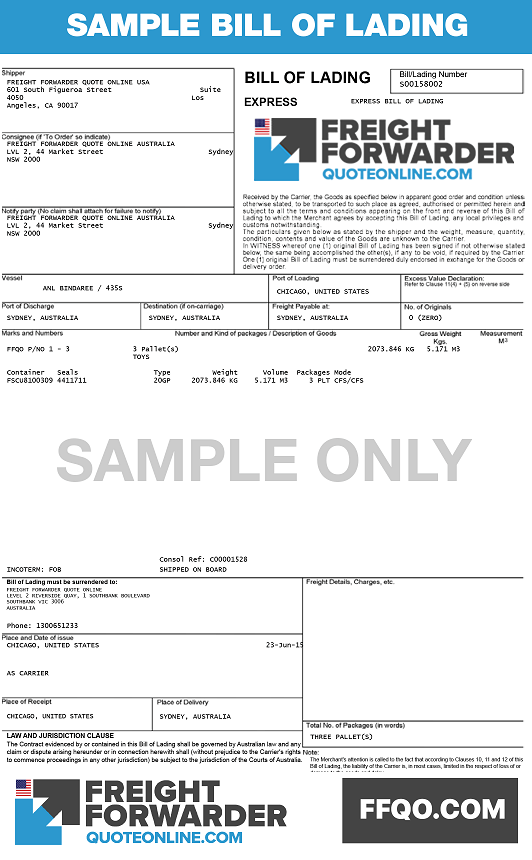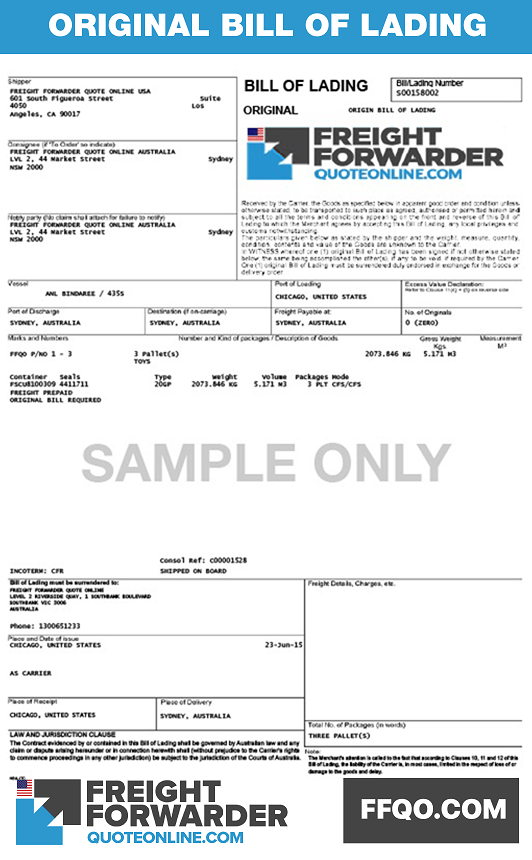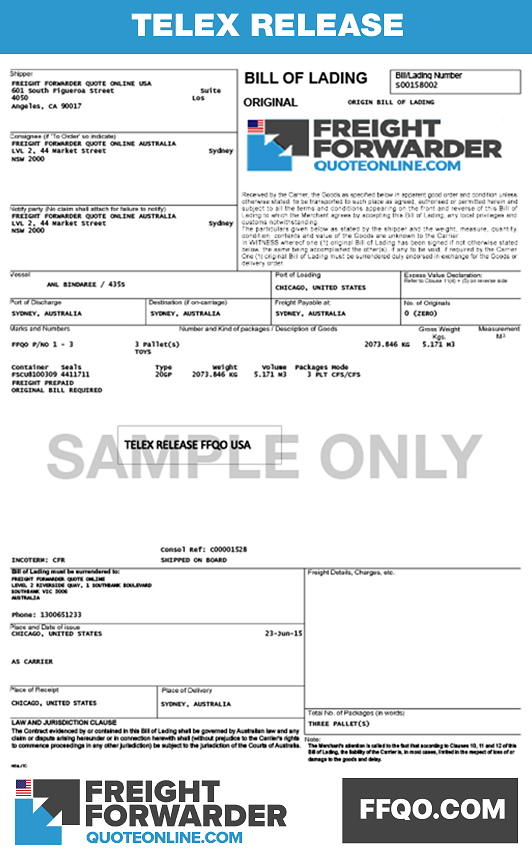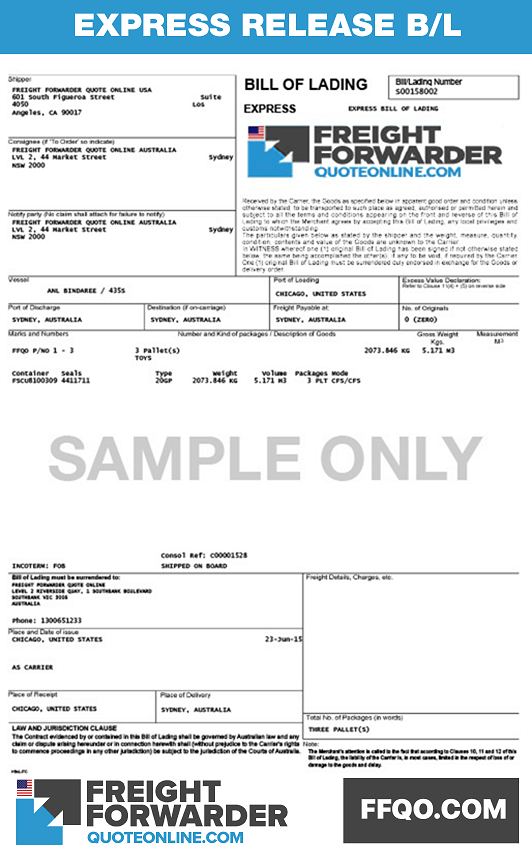You’ve been requested to forward a bill of lading to your freight forwarder. This, however, is your first time importing or exporting a product to/from the US. You call for help because you’re unclear what is being requested.

Bill of Lading 101
Here’s an easy guide that will help you understand the infamous Bill of Lading.
- What’s in a bill of lading?
- Why is it important?
- How are bills of lading issued and processed?
- What are the different types of bills of lading?
- So what’s the best choice for my B/L release?
What’s in a bill of lading?
It is sometimes referred to as a ‘B/L’ or ‘BoL’. It is a document showing the agreement between individuals, groups, companies and corporations. It contains such details as the:
- Owner of the goods
- Freight forwarder of the items
- Receiver of the goods
This is an example of a bill of lading.

Sample bill of lading
Why is it important?
The bill of lading is one of the most important documents for an importer or exporter. Without it, transactions between freight forwarder, shipping lines, importer and exporter would be impossible.
It is one of two critical items of shipping documentation. The other is the letter of credit.
The bill of lading details the following:
- Seller
- Receiver
- Notifying party
- Shipping terms
- General consignment
It also includes container and general merchandise information such as packages, weights, cubic meters or feet. It dictates to or from where the cargo is to be shipped. (In some cases – such as where there may be two ports – this can be quite technical.
How are bills of lading issued and processed?
Bills of lading can be issued as an original, and couriered from seller to buyer as receipt of release. This can then be processed as a Telex or Express Release once the seller receives payment. The seller surrenders the original back to the original forwarder, who then allows release without the original.
They can also be issued as waybills. These are generally used for sellers who provide buyers with credit terms, or when products are paid for prior to arrangement of consignment.
What are the different types?
Great! You’ve now learned the basic things about bills of lading. It’s now time to learn about the different types of bill of lading that can be issued to you.
House bill of lading
This is issued by the forwarder, based on the information received from the seller via the forwarding instruction.

Sample house bill of lading
Ocean bill of lading
This is issued by the shipping company based on the forwarding instructions. It is generally issued from forwarder to forwarder relative to service contracts. It prevents importers and shippers from booking direct via the master carrier.
Through bill of lading
You’ll find this type of bill of lading common in shipments containing both sea and airfreight in the same transaction. These are helpful in avoiding full airfreight costing while providing better transit time.
Switch bill of lading
There are instances in which the importer or exporter would not want supplier or shipper details to be visible to customers. In these cases the switch bill of lading is used.
The switch bill of lading is generally used for ‘sold as’ consignments. This involves one bill of lading between the shipper and the company as the consignee, then an additional bill showing your company as shipper and your customer as the consignee.
What are the different release types available for house bill of lading
You’re getting there. Just a few more interesting things to explain so you understand the terms associated with your bill of lading.
Original
Original bills of lading are issued in only three copies. We strongly recommend you retain one for safekeeping in case this is required in future.

Original bill of lading
When is this needed?
Some destination forwarders require that an original bill of lading is presented prior to release of your consignment.
Why?
The original bill of lading proves the cargo is void of any liability and payment from customers has been settled. For this reason most suppliers prefer to operate using the original bill.
Telex Release
There are instances where the original bill of lading may not be required. On these occasions Telex or Express Release may be accepted.

Sample telex release bill of lading
What is a telex release?
A Telex Release is a copy of the original bill sent to your destination forwarder via email. This is their ‘go’ signal to release your freight.
When is a telex release requested?
Shippers generally request original bills. A Telex or Express Release may, however, be requested when payment has been received.
The logic here is that it guarantees the importer/exporter has fulfilled their financial obligation.
Are there various types of telex release?
You’ll find two types of Telex Release:
- Copy of the bill of lading with telex stamp
- Note on the bill from the sending forwarder
Want to learn more about Telex Release? In our next blog we will discuss Telex Release further.
Express Release
Express release is an alternate term to Telex Release. See telex release for complete details.

Sample express release bill of lading
Sea Waybill
Do you want a fast release of your shipment? Choose a sea waybill. This privilege, however, is a facility shippers provide to customers with whom they have had long standing arrangements or credit terms.
Deal with freight forwarders that have long standing relationships with shippers. Call FFQO at 1-877-901-2004.
So what’s the best choice for my B/L release?
We highly recommend the use of Telex or Express Release. This is the quickest way to release your consignment. If, however, you are receiving original bills, please ensure you send only one or two as a maximum because it is always best to have a spare original bill of lading.
Got freight forwarding questions? Ask the expert. Feel free to contact us online and send a message. You can even message us on Facebook.
PS – A related important document is Letter of Credit. Click here to learn more about the letter of credit.




